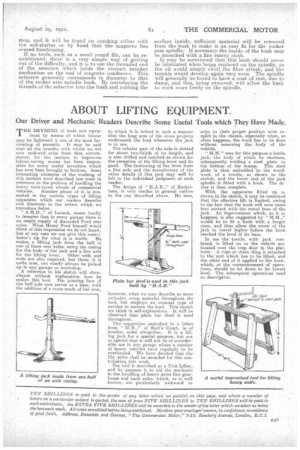ABOUT LIFTING EQUIPMENT.
Page 27

If you've noticed an error in this article please click here to report it so we can fix it.
Our Driver and Mechanic Readers Describe Some Useful Tools which They Have Made.
THE DEVISING of tools and equipMeat by means of which labour may be lightened is one.of the most fascinating of pursuits. it may be said that all the benefits with which we are now endowed arise from that circumstance, for the instinct to improvise labonr-saving means has been responsible for every useful invention which has ever been brought to fruition. Some interesting examples of the working of this instinct were described last week in reference to the problem of handling the heavy twin-tyred wheels of commercial vehicles. Another phase of it is presented in the various types of lifting apparatus which our readers describe arid illustrate in the letters which we reproduce below.
" A.M.D.," of Lanark, seems fondly to imagine that in every garage there is an ample supply of discarded Ford rear axles. What Henry Ford himself would think of this impression we do not know, but at any rate we can give this contri lnitor's tip for what it is worth, He makes a lifting jack from the half of one of these rear axles, using the casing for the body of the jack and a live axle for the lifting lever. Other odds and ends are also required, but these, it is quite true, can nearly always be picked up in any garage or workshop. A reference to his sketch will show, almost without explanation, how he makes this tool. The jointing face of the half-axle case serves as a base, with the addition of a cross made of bar iron, to which it is bolted in such a manlier .that the long arm of the cross projects underneath the load whenever the jack is in use.
The tubular part of the axle is slotted for about two-thirds of its length, and is also drilled and notched as shown for the reception of the lifting lever and its pawl. The fashioning of the lever from a live axle and the manufacture of the other details of this jack may well be left to the individual judgment of each reader_ The design of " H.A.B.," of Rotherham, is very similar in general outline to the one described above. He uses, however, what we may describe as more orthodox scrap material throughout the tool, but employs an unusual type of ratchet to sustain the load. This sketch we think is self-explanatory. It will be Observed that plain bar steel is used throughout.
The suggestion embodied in a letter from " M.M.," of Earl's Court, is of another order, altogether. It is a lifting jack for a special purpose, but not so special that it will not be of considerable use in any garage where a number of heavy vehicles have regularly to be overhauled. We have decided that the 15s, prize shall be awarded for this contribution, this week.
The tool is described as a 'Unit Lifter, and its purpose is to aid the mechanic in the handling of heavy units like gearboxes and back axles, which, as is well known, are particularly awkward to
raise to their proper position -with respect to the chassis, especially when, as often happens, the work has to be done without removing the. body of the vehicle.
"MM." uses for this pull:lose a bottle jack,the body of which he shortens, subsequently welding a steel plate to the bottom of the stump. This steel plate is then embedded inthe woodwork of a trestle, as shown in the sketch, and the lower end, of the jack spindle is fitted with a hook. The de vice is then complete.
With the apparatus fitted up at, shown in the sketch, it may be remarked that the effective lift is limited, owing to the fact that the hook will soon come into contact with the metal base of the jack. An improvement which, as it so happens, is also suggested by " MM.," would be to fit a hook with a longer stern, and thus allow the screw (if the jack to travel higher before the hook reached the level of its. base.
In use the trestle, with jack corn. bined, is lifted on EU the vehicle anc located over the trap door in the platform. A rope or chain sling is attached to the 'unit which has to be lifted, and the other end of it applied to the hook, which, at the commencement of operations, should be let down to its lowest level. The subsequent operations need no description.




























